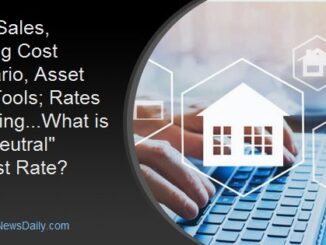
Could a housing recovery possibly be underway?
In March, mortgage rates ended the month over 30 basis points lower than where they started as more buyers returned to the market. Home sales prices also fell year-over-year in February—the first time in nearly 11 years—and total home sales saw their largest monthly percentage increase since July 2020. However, many economists remain mixed about how much more home prices will drop this year.
For one, the nation’s housing supply remains limited. Those who purchased homes in recent years at record-low interest rates are staying put. Tight inventory issues, in part, are also keeping prices from dropping off, which is perpetuating affordability challenges for many, especially first-time homebuyers.
Though home prices remain high year-over-year, they’re not as eye-popping as they were in early 2022. Even so, how much further home prices dip in 2023 will likely depend on where mortgage rates go.
Housing Market Forecast for April 2023
As we move into spring homebuying season, housing experts maintain a watchful eye on the economy, which continues to be pulled in all directions by high inflation, steep interest rates, ongoing geopolitical uncertainties and recession fears, to name a few.
However, some promising trends are developing. The median existing-home sales price was down 0.2% to $363,000 in February compared to a year ago, according to the National Association of Realtors (NAR). This ends a record streak of 131 consecutive months of year-over-year increases. Total existing-home sales jumped 14.5% from January to February—ending a run of 12 consecutive months of declining sales—but were still down 22.6% from a year ago, per NAR.
Housing starts also rose 9.8% in February, according to preliminary data from the U.S. Census Bureau and the U.S. Department of Housing and Urban Development (HUD), helping to provide much-needed inventory. Mortgage rates, meanwhile, continue to oscillate up and down. Following a year-to-date peak in early March, rates fell for five consecutive weeks but have since ticked back up.
Despite the latest uptick, recent rate declines seem to be luring at least some shoppers off the sidelines. And even as home price growth slows and sales transactions increase, some experts remain cautiously optimistic the housing market is in a recovery.
“Prices need to drop more, and across more markets, before a general revival can occur,” said Robert Frick, corporate economist at Navy Federal Credit Union, in an emailed statement.
Housing Inventory Outlook for April 2023
Low housing inventory has been a challenge since the 2008 housing crash when the construction of new homes plummeted. It hasn’t fully recovered—and won’t in 2023.
Housing supply remaining stuck at near historic lows has propped up demand compared to other downturns, consequently sustaining higher home prices.
“[D]eclining rates have brought borrowers back to the market but, as the spring homebuying season gets underway, low inventory remains a key challenge for prospective buyers,” said Sam Khater, chief economist at Freddie Mac, in a press statement.
At the current sales pace, unsold inventory is at a 2.6-month supply, according to NAR, which is low by historical standards, though up from 1.7 months a year ago.
“Inventory levels are still at historic lows,” said Lawrence Yun, chief economist at NAR, in a report. “Consequently, multiple offers are returning on a good number of properties.”
Based on this and other data, industry experts have a gloomy outlook on when inventory will eventually normalize.
“I believe that we’re likely to see low inventory continue to vex the housing market throughout 2023,” says Rick Sharga, executive vice president of market intelligence at ATTOM Data. And with 70% of homeowners sitting on a mortgage rate of 4% or less, Sharga says we’re unlikely to see an inundation of homes soon.
Housing Starts Forecast 2023
At the same time, there are positive signals in the homebuilding realm. Following five consecutive months of declines, single-family construction starts in February rose 9.8%, and applications for building permits increased by 13.8% from the previous month, according to the U.S. Census Bureau and HUD.
The latest builder outlook data reflected optimism as well.
The most recent National Association of Home Builders (NAHB)/Wells Fargo Housing Market Index (HMI), which tracks builder sentiment, rose two points, from 42 to 44. This is the third month-over-month increase following 12 consecutive months of declines.
Even so, builder confidence is still low—50 or above means more builders see good conditions ahead—so there will need to be more consecutive upticks before we see a significant rebound in new construction.
Also, the Federal Reserve isn’t helping matters with its ongoing federal funds rate hikes. At a semiannual hearing before the Senate Banking Committee, Federal Reserve Chair Jerome Powell addressed questions about the Fed’s aggressive monetary tightening policies in its efforts to rein in inflation.
In an exchange with Senator Raphael Warnock (D-Ga.), Powell acknowledged that raising the central bank interest rate increases borrowing costs for companies that develop new housing and makes financing and expanding production for suppliers more expensive. He also conceded that elevated fixed mortgage rates discourage homeowners with a low-rate fixed-rate mortgage from selling their homes.
All of these circumstances put further strain on inventory.
“The bottom line is that there really isn’t a likely scenario that leads to inventory levels approaching historically normal numbers in 2023, which means that prospective homebuyers are still going to have to work hard to find something to buy,” says Sharga.
Will the Housing Market Crash?
Due, in part, to the ongoing inventory problem keeping home prices elevated, many economists predict the housing market is more likely to correct itself from the double-digit percentage jumps seen in home prices the past few years rather than crash.
“[H]ome prices will be steady in most parts of the country with a minor change in the national median home price,” said Yun.
However, some housing market watchers believe that homes in some areas could see sales and price growth, particularly in locations where home prices have remained affordable over the past few years in relation to median income.
“We’re estimating about a 5% drop nationally,” says Sharga. “Some markets, believe it or not, will probably see prices continue to increase.”
Yun concurs, noting that home prices will see gains or declines depending on the region, with lower-priced locations likely to experience price increases and expensive areas seeing dips.
Other experts point out that today’s homeowners also stand on much more secure footing than those coming out of the 2008 financial crisis, with a high number of borrowers having positive equity in their homes. Consequently, the likelihood of a housing market crash is low.
“Homeowner equity is at the highest level it’s been in the past several decades, so homeowners have a lot of value in their home,” says Nicole Bachaud, an economist at Zillow.
In a housing market crash, you would typically see a 20% to 30% drop in home prices and a decline in home sales—far more than what’s currently happening. Another crash symptom that’s been missing is a jump in foreclosure activity.
“I think we’re more likely to see the market cool, rather than crash,” Sharga says.
Will Foreclosures Increase in 2023?
Even with the steady rise in foreclosures that resulted after the expiration of the Covid-19 foreclosure moratorium in September 2021, foreclosures remain below pre-pandemic levels. In 2022, foreclosures were down 34% compared to 2019, according to ATTOM Data’s Year-End 2022 U.S. Foreclosure Market Report.
“It seems clear that government and mortgage industry efforts during the pandemic, coupled with a strong economy, have helped prevent millions of unnecessary foreclosures,” said Sharga.
For February 2023, foreclosures were up 18% from a year ago and down 3% between January and February.
A key difference now compared to the 2008 housing crisis is that many homeowners, and even those struggling to make payments, have had a large boost to their home values in recent years. That means they still have equity in their homes and are not underwater—when you owe more than the house is worth.
Sharga noted that borrowers in foreclosure are leveraging the positive equity in their homes by refinancing their home or selling for a profit. “It seems likely that this is a trend that will continue in 2023,” Sharga said.
When Should I Buy a Home in 2023?
Buying a house—in any market—is a highly personal decision. Because homes represent the largest single purchase most people will make in their lifetime, it’s crucial to be in a solid financial position before diving in.
Use a mortgage calculator to estimate your monthly housing costs based on your down payment and interest rate.
Trying to predict what might happen this year is not the best homebuying strategy. “Buyers sitting on the sidelines today in anticipation of lower prices tomorrow may end up disappointed,” says Neda Navab, president of the U.S. region at Compass, a real estate tech company.
Navab expects home prices in the hotter markets during the past few years to decrease somewhat, but she doesn’t expect a widespread, national price decline like what followed the 2008 financial crisis.
Instead of waiting for much lower prices, experts suggest buying a home based on your budget and needs. If you find a home you love in an area you love, and it also fits your budget, then chances are it might be right for you. However, if you make too many sacrifices just to get a house, you may end up with buyer’s remorse, potentially forcing you to offload the house.
Tips for Buying in Today’s Housing Market
Even as prices soften, you may realize that the area where you want to buy a home is still out of reach, so it’s important to be flexible.
“If you badly want a house and can work remotely or switch jobs, moving to lower-priced housing markets is a good idea to consider,” says Frick. “Millions of Americans have done that already.”
Also, get all your ducks a row in advance—review your financial situation, gather required documents, shop multiple lenders and strengthen your credit score. That way, when you find your dream home, you’ll be in a better position to act fast in a tight market.
“Only the best prepared, with their financing lined up, a solid understanding of what they can afford, and constant checking of prices and listings will be successful in today’s highly-competitive market,” says Frick. “Know how much your monthly payment will be—complete with taxes—and how well that fits into your budget.”
Tips for Selling in Today’s Housing Market
The first step for a successful sale is to find a listing agent who knows the area and comes highly recommended. A good agent will work closely with you to price your home competitively while fielding questions and offers from prospective buyers.
Rita Tayenaka, owner of Orange County, California-based Coast to Canyon brokerage, points to the outsize number of homes falling out of escrow recently as a cautionary tale for sellers who continue to demand 2021 prices. “Everyone thinks their house is special,” she says.
Even though the market may still be tipped in your favor, it’s in your best interest to present your home in the best possible light. Not everyone has cash dedicated to renovations and repairs, but a little sweat equity can go a long way. The first step is to declutter, organize and clean. Even if your home is outdated, a clean space gives buyers a chance to envision the house’s potential.
Source: www.forbes.com
ENB
Sandstone Group



